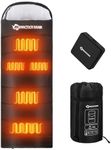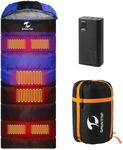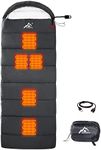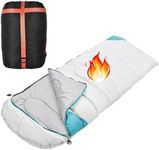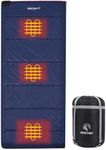Buying Guide for the Best Electric Sleeping Bag
Choosing the right electric sleeping bag can make a significant difference in your outdoor sleeping experience. An electric sleeping bag provides additional warmth through built-in heating elements, making it ideal for cold weather camping or outdoor activities. To find the best fit for you, it's important to understand the key specifications and how they align with your needs.Temperature RatingThe temperature rating indicates the lowest temperature at which the sleeping bag can keep you warm. This is crucial because it helps you determine if the sleeping bag is suitable for the conditions you'll be facing. Temperature ratings are usually divided into three segments: summer (above 35°F or 2°C), three-season (10°F to 35°F or -12°C to 2°C), and winter (below 10°F or -12°C). Choose a temperature rating based on the coldest conditions you expect to encounter. For example, if you plan to camp in winter, opt for a winter-rated bag.
Heating ElementsHeating elements are the built-in components that provide additional warmth. They are important because they enhance the sleeping bag's ability to keep you warm in extremely cold conditions. Heating elements can vary in terms of coverage and heat settings. Some bags have full-body coverage, while others focus on specific areas like the feet or torso. Consider your personal comfort and the areas where you tend to feel the coldest when choosing the right heating element configuration.
Battery LifeBattery life refers to how long the heating elements can operate on a single charge. This is important because it determines how long you can rely on the additional warmth provided by the electric components. Battery life can range from a few hours to an entire night, depending on the settings and the battery capacity. If you plan to use the heating elements throughout the night, look for a sleeping bag with a longer battery life. For shorter uses, a lower battery life may suffice.
Material and InsulationThe material and insulation of the sleeping bag affect its overall warmth, comfort, and durability. Common materials include synthetic fibers and down. Synthetic materials are generally more affordable, quick-drying, and perform better in wet conditions, while down offers superior warmth-to-weight ratio and compressibility. Insulation is important because it provides the primary warmth, with the electric heating elements offering supplementary heat. Choose a material and insulation type based on your preference for weight, packability, and the conditions you'll be facing.
Size and FitSize and fit are crucial for comfort and warmth retention. A sleeping bag that is too large can leave empty spaces that make it harder to stay warm, while one that is too small can be uncomfortable and restrict movement. Sleeping bags come in various sizes, including regular, long, and wide options. Consider your height and body shape when selecting the size. A well-fitting sleeping bag will ensure better heat retention and a more comfortable night's sleep.
Weight and PackabilityWeight and packability are important for ease of transport, especially if you plan to carry the sleeping bag on long hikes or backpacking trips. Lighter and more compressible sleeping bags are easier to carry and take up less space in your pack. However, they may offer less insulation compared to heavier options. Balance the need for warmth with the need for portability based on your specific use case. If you are car camping, weight may be less of a concern compared to backpacking.

